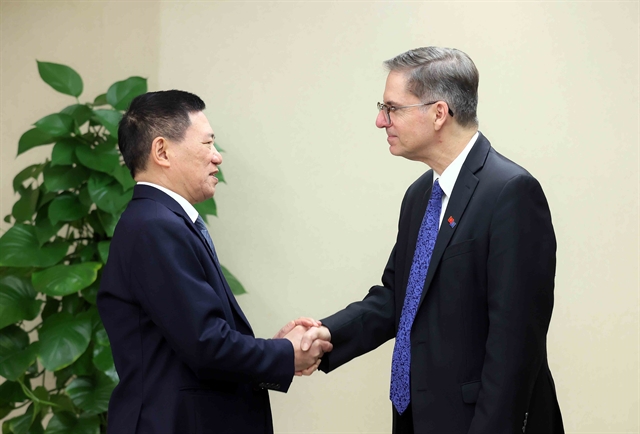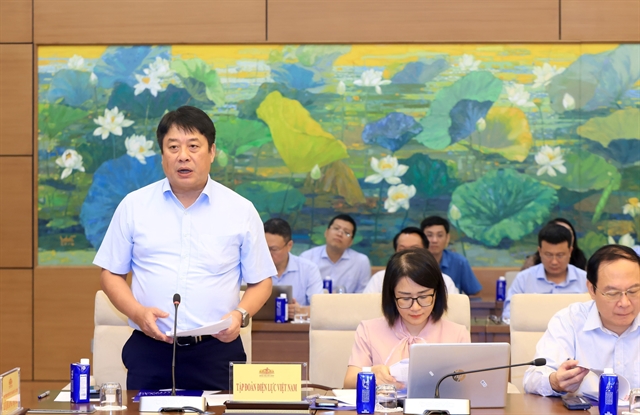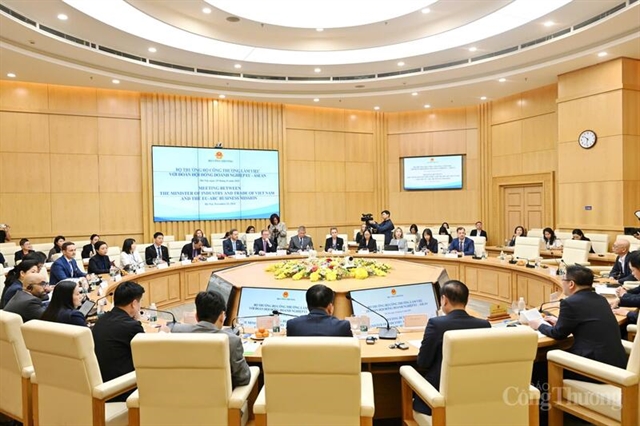 Politics & Law
Politics & Law


|
| Việt Nam Electricity (EVN) General Director Nguyễn Anh Tuấn speaks at the working session with the National Assembly’s supervisory delegation on Wednesday. VNA/VNS Photo Tuấn Anh |
HÀ NỘI — The National Assembly’s supervisory delegation has urged Việt Nam Electricity (EVN) and the Việt Nam National Chemical Group (Vinachem) to step up their green energy transition efforts and tighten controls over hazardous waste and chemical management.
The call was made on Wednesday during a working session chaired by National Assembly Vice Chairman Lê Minh Hoan, who leads the delegation, with discussions centred on the enforcement of environmental protection laws since the Environmental Protection Law 2020 took effect.
During the session with EVN, the supervisory delegation demanded explanations regarding the group’s compliance with industrial emission regulations and wastewater separation systems at the Phú Mỹ Power Centre. It also raised concerns from voters about coal dust and ash at the Vĩnh Tân Thermal Power Centre, particularly Vĩnh Tân 4 Plant.
In response, EVN General Director Nguyễn Anh Tuấn said that most of the group’s coal-fired power plants have been equipped with emission treatment systems that meet national standards, including dust filters, electrostatic precipitators, and systems to reduce sulphur dioxide (SO₂) and nitrogen oxides (NOₓ) emissions.
However, some older plants, such as Phả Lại 1 and Ninh Bình, still lack comprehensive systems.
Regarding wastewater, he said all plants have compliant treatment systems, and several have separated stormwater and industrial wastewater systems as required by the 2020 law.
Between 2021 and 2025, EVN generated 42.21 million tonnes of ash and slag, of which 43.91 million tonnes were reused, accounting for 174 per cent of the volume generated, primarily in building materials and land reclamation.
EVN has also strictly complied with regulations on solid waste classification, storage, and handover to licensed treatment units.
On the energy transition, digital transformation, and carbon neutrality, EVN is pursuing a just energy transition strategy, researching new technologies such as offshore wind, ammonia-biomass co-firing, circular economy models, and ESG (Environmental, Social, and Governance) impact assessments.
NA Vice Chairman Hoan acknowledged EVN’s considerable efforts and progress in pollution control, waste treatment, and its shift to cleaner energy sources.
However, he emphasised the ongoing challenges, including outdated technologies, ash and slag handling, greenhouse gas emissions management, and the need for greater investment. These issues, he warned, pose environmental and public health risks and threaten EVN’s own sustainable development.
He urged EVN to treat environmental protection as a top strategic priority, stressing it is a matter of survival for the sector. He called for a comprehensive internal review and upgrade of the group’s environmental management systems to ensure full compliance with the 2020 law and associated regulations.
NA Vice Chairman Hoan also encouraged the group to proactively propose amendments to existing legislation, ramp up green energy investments, and improve environmental incident preparedness and response.
In his conclusion, Lê Quang Huy, Chairman of the NA’s Committee on Science, Technology and Environment and permanent deputy head of the supervisory delegation, requested that EVN supplement its report with more detailed data on environmental protection efforts and address specific concerns raised by lawmakers.
The delegation also called on EVN to tackle remaining issues, such as unresolved ash and slag disposal at the Vĩnh Tân Power Centre, and to prepare for the new emission standards that will come into force on July 1, 2025.
Chemical industry urged to take greater responsibility
At the working session with Vinachem, Deputy General Director Lê Hoàng reported that in May 2025, the group launched its green and digital transformation roadmap aligned with sustainable development goals. Vinachem has also instructed all member units to conduct greenhouse gas inventories in line with legal requirements.
As of June 30, 2025, more than 7.4 million tonnes of ash, gypsum, and other industrial waste were stockpiled at disposal sites, including 3.85 million tonnes at DAP-Vinachem and 3.63 million tonnes at DAP 2-Vinachem. The latter has partnered with other firms to implement a gypsum recycling line with a capacity of 850,000 tonnes per year. However, many relevant technical standards and regulations have yet to be issued by ministries, creating regulatory gaps.
NA Vice Chairman Hoan underlined the chemical industry’s strategic role in supporting other industrial sectors and contributing significantly to the economy. Yet, he warned, the inherent risks in chemical production, storage, and transportation demand heightened responsibility and rigorous oversight.
He urged Vinachem to strictly comply with all provisions of the Environmental Protection Law 2020 and the newly enacted Chemical Law 2025, particularly those governing chemical management, hazardous waste and environmental licensing.
In addition, he called on the group to proactively propose legislative revisions and develop a clear roadmap to eliminate outdated technologies, adopt energy-efficient, low-emission, and environmentally friendly solutions, and aim for less waste production, not just better waste treatment. — VNS




